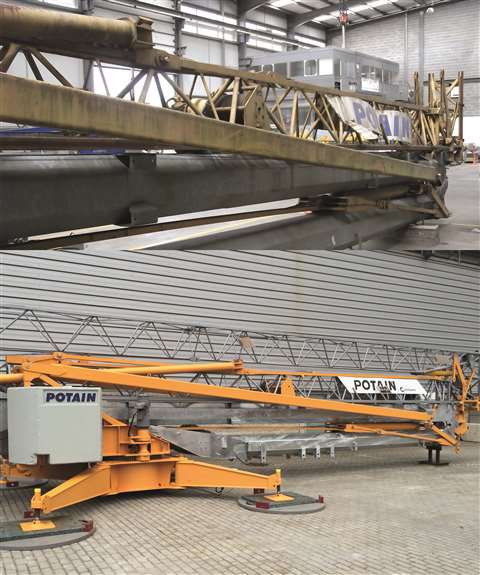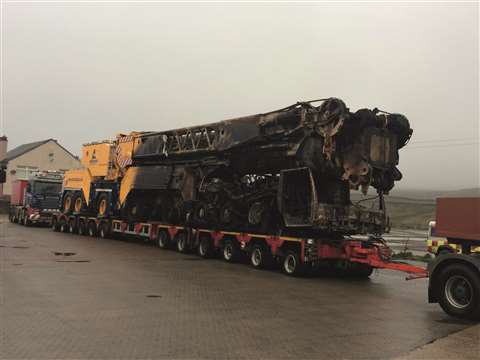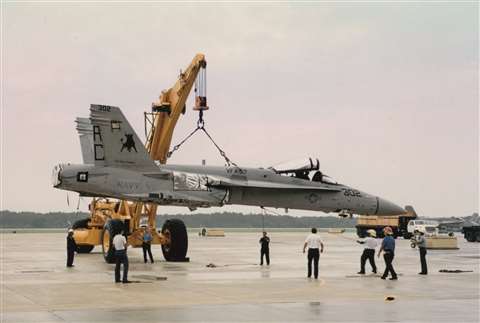Repair and refurbishment: Replace or repair?
05 February 2018
Many factors should be considered when deciding whether or not to restore a crane or to replace it with a new one. Christian Shelton reports
There are many reasons why crane owners might choose to repair or refurbish a crane rather than buy a new one. The main reason is usually cost. Depending on exactly how much work needs to be done, repairing a damaged crane can be cheaper and quicker than buying a new replacement. There is also the availability of parts to consider. The crane or its parts may no longer be manufactured, making repair or refurbishment the only option. Another factor is user preference. Crane operators become familiar with the machines they have and may be reluctant to try something new, making repair and refurbishment preferable over buying new.
Once the decision to repair or refurbish has been made, there are generally two options available to crane owners, depending on the make of their crane: if available, they can use the OEM’s (original equipment manufacturer’s) repair and refurbish service; alternatively, they can use the services of an independent, dedicated repair and refurbishment specialist.
OEM services
German crane manufacturer Liebherr offers extensive repair and refurbishment coverage, with three facilities in Germany, and others in France, United Kingdom, Italy, Spain, South Africa, Australia, Russia, and the USA. The company says it has seen a shift in the type refurbishment and repair requests it has received over the last few years. “We have seen less demand for completely reconditioned and painted cranes; instead customers are requesting technically refurbished cranes,” says Liebherr spokesperson Wolfgang Beringer. “Our most common repair and refurbish jobs are on main components such as cylinders, slewing bearing, engines, transmissions.
As such, our refurbishment and repair personnel are well educated with a relevant background in areas such as mechanics, electronics or mechatronics. In addition, our staff are regularly trained in all our new technologies.”
Beringer also notes the availability of parts as being a key factor. “Sometimes you must repair as new parts may not be available,” he says.
USA-headquartered crane manufacturer Manitowoc has a dedicated rebuild, repair, remanufacture and exchange programme for all models of Manitowoc, Grove and Potain cranes. It’s called the EnCore programme and it has been running since 2011.
Through the EnCore programme Manitowoc offers various levels of refurbishment and, depending on the condition of the crane, crane owners can choose either an entry, standard or premium level of refurbishment. Standard across all levels is: a full inspection and calibration of all controls; the repair or replacement of slewing ring bolts; the repair replacement of hoisting steel wire ropes; and a final functional test report.

At the premium level the entire crane structure’s surface is shot-blasted, cleaned and repainted. The control system is overhauled, all mechanical and electrical components are repaired or replaced, and a full set of safety and function tests are completed. The crane then gets an EnCore accredited plate indicating the date of refurbishment. The premium level comes with a six-month warranty. The standard level comes with a three-month warranty. And the entry level comes with a one-month warranty.
Manitowoc has three EnCore facilities in Europe and one in North America. Specifically, these are in: Lagenfeld, Germany; Buckingham, UK; Breda, the Netherlands; and Bauxite, Arkansas, USA. In addition, there are several independent, certified EnCore partners that Manitowoc works with to perform the work. According to Manitowoc, customers typically visit an EnCore facility to see a refurbished crane, enabling them to inspect and operate the machine before they purchase.
Manitowoc reports that its EnCore programme is particularly strong in emerging or less economically strong markets. In Europe, for example, Manitowoc says it has a strong EnCore presence in Poland, Czech Republic, Hungary and Slovakia – as these countries tend to buy more used cranes with warranties. Manitowoc says it sees little used business in China or India as these are more mature markets, while the Middle East is mixed because it has strong connections with China and India.
A large element of EnCore’s work comprises crane modifications. These vary depending on users’ needs and modifications are typically guaranteed for three to six months, Manitowoc says.
The company also offers finance options for EnCore purchases. It claims this supports lease agreements and, unlike traditional lending, Manitowoc says its financial products don’t affect bank lines of credit, leaving customers’ capital resources intact for times when they need ready access to cash.
Manitowoc points out its strategy is to use the same sales and distribution channels for used cranes as for new cranes because it doesn’t want to create competition between its new and used products.
“The benefits of EnCore are clear,” enthuses Manitowoc’s Central Europe sales director, Erdo Arslan. “Customers have access to a refurbished crane that comes with a warranty for less of a capital investment than a new crane. Also, some customers may prefer an older model crane or have a crane that they would like to keep in their fleet, in which case EnCore is also an ideal option for them.
“The second-hand crane market is healthy all over the world. It has been very stable over the past several years, without any severe ups or downs. Less economically strong countries, in particular, are looking for a low investment cost in their cranes and capital equipment, which basically means used equipment.”
Complementing the EnCore programme is a dedicated website, www.Manitowoc-used.biz, for mostly Manitowoc-owned used cranes. The site was redesigned in 2017 and, according to the company, offers a quick and direct way for buyers to acquire a used Manitowoc crane. The site is managed by Manitowoc’s European operations and features Manitowoc-owned cranes predominantly based in that region, although the cranes are available for sale worldwide.
Independent specialists
Certified Boom Repair Service is a North American company with over 35 years of experience in crane and heavy equipment repair and maintenance. As an independent, the company is acutely aware of the factors that determine whether or not crane owners use its services. “Market conditions certainly weigh on a decision to restore or refurbish a crane. The owner has to feel there is enough business to justify spending the time and money involved,” says Tyler Smith, vice president of business development at Certified Boom Repair. “Aging cranes can often be refurbished for half the cost of buying a new one and can be put in excellent operating condition. However, when the repair cost exceeds 60 to 70 percent of the value of the crane then crane owners might be better off buying new.”

When the repair cost exceeds 60 to 70 percent of the value of the crane, then crane owners might be better off buying new, advises Tyler Smith of Certified Boom Repair
Wheco is another American company that has been repairing and restoring cranes and lifting equipment for over 35 years. It services clients in both the private and government sectors around the world carrying out what it describes as, “high-quality, documented, warrantied, and certified repairs to nearly every type of complex heavy equipment.”
Wheco’s first repair and refurbishing contract was to service and repair rough terrain cranes and large aerial lifts for a National Powerline Company which were used all over the USA. Wheco says that the terrain this equipment was used in was often very rough and thus hard on the equipment. Wheco has also undertaken repair and service work for the army, navy, marines and NASA.

Wheco refurbished US Navy crash and salvage crane originally built in the 1960s and 1970s
According to David Wood, president at Wheco, “the decision on whether to repair or refurbish a damaged or old crane comes down to its value and what the owner is looking for in a return on investment. Some older cranes are just not worth the investment to bring them up to a safe and reliable long-term condition.”
One job Wheco undertook for the navy, however, was unusual in that it saw the company refurbish some crash and salvage cranes built in the 1960s and 1970s. “They had served the navy well but were in dire need of either replacement or rebuilding,” explains Wood. “We won a contract to rebuild 15 of them, although only five were ever finished as funding dried up. These cranes had a special use that at the time would have cost many times more to replace than to remanufacture.”
Buyer beware
When considering whether or not to repair or refurbish a crane, crane owners should be careful not to let potential cost savings be the only determining factor. Cheap repairs might save money in the short term but if they compromise safety or even functionality then it is a false economy. “Make sure you pick a company that has experience because there are many factors to consider and be aware of when refurbishing a crane,” advises Smith from Certified Boom Repair.
“Look for a good partner,” seconds Wood at Wheco. “It takes both sides working together to make a refurbishment project successful. We need to know the complete history of the machine and what the expectations and budget are of the owner. There cannot be any secrets or the outcome is destined to fail.
“Look at what the company has done before and see if they can provide examples and references from these past projects. Find out how long the repair or refurbishment will take and discuss worst case scenarios up front so both parties understand what can, could and will happen. Try and set up a rate structure up front that both sides agree to. Finally, find out if the refurb company has a relationship with the OEM and whether there will be any warranty when the job is complete.”
Although this might sound like a lot of extra work, it is worth it in the long run. The security of knowing that any repairs or refurbishments have been done to the OEM’s specifications or by a high quality independent is worth its weight in gold.






